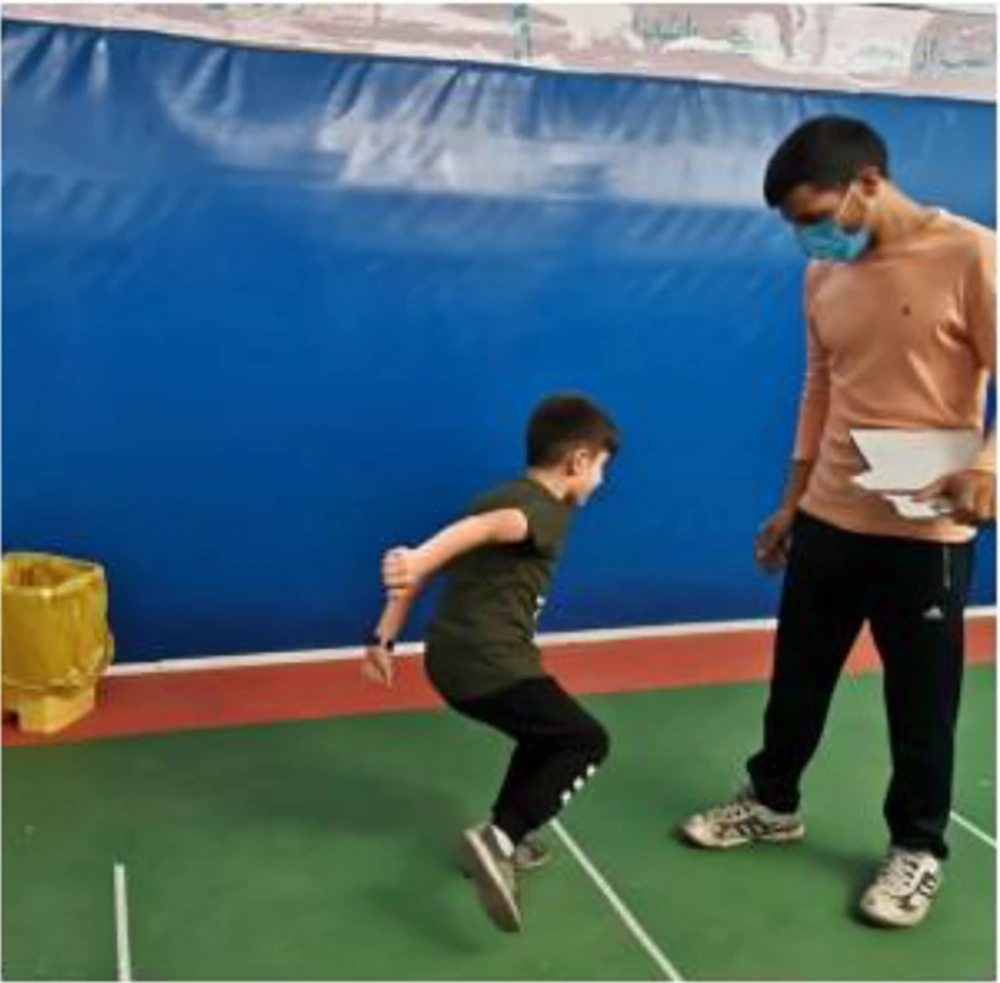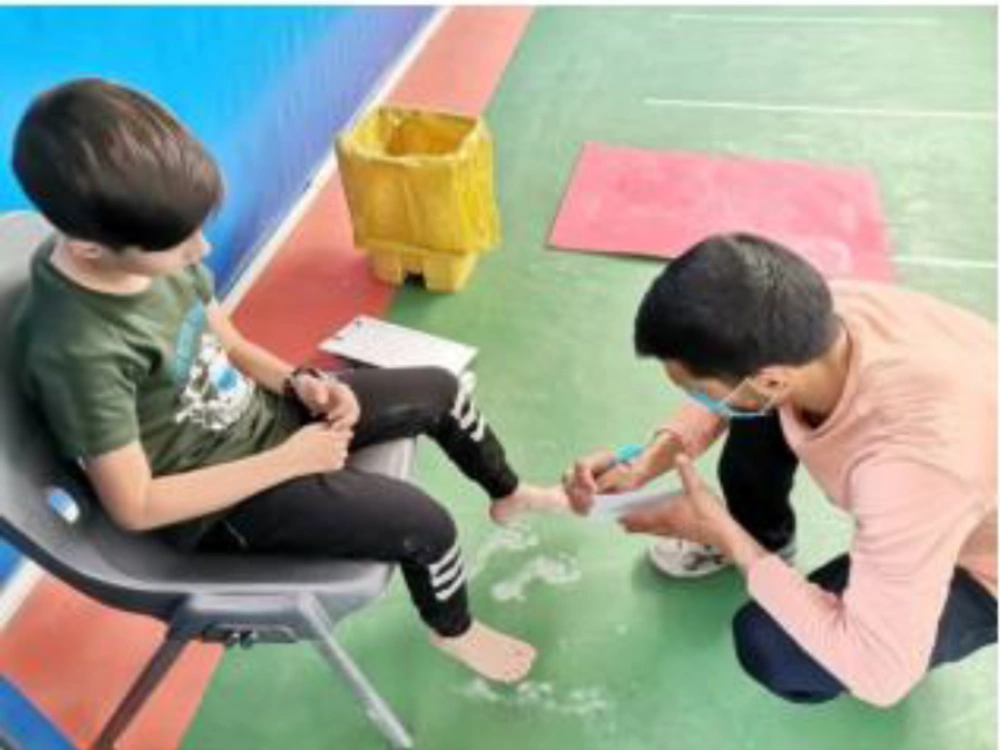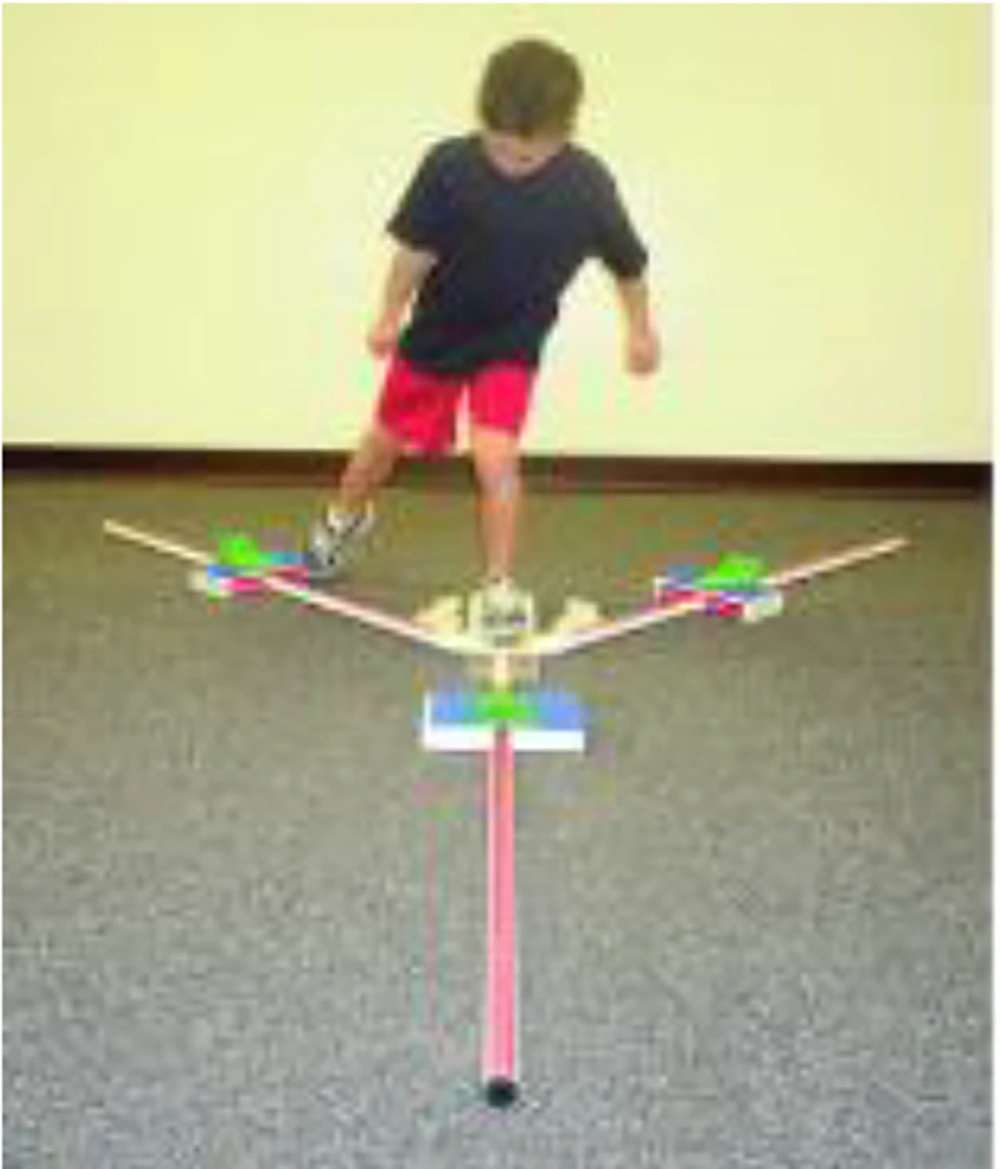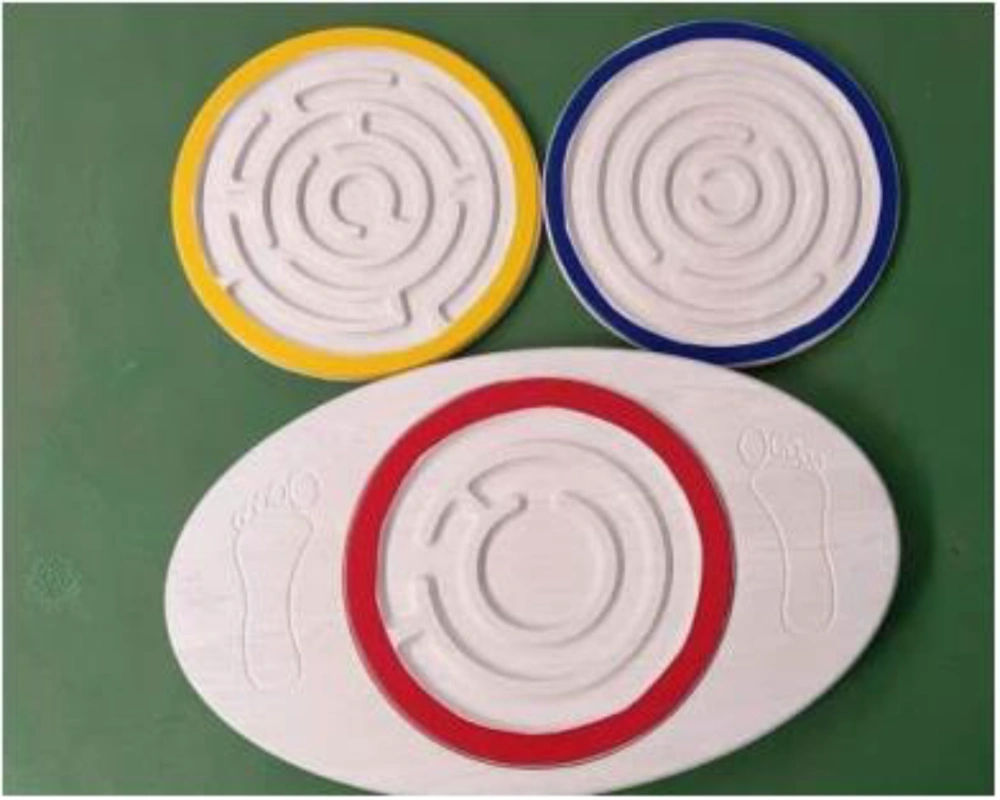1. Background
Flatfoot is one of the common reasons for children to visit pediatricians, podiatrists, and orthopedic surgeons (1). The first type of this deformity, known as flexible flatfoot, exhibits changes in the muscles and ligaments, causing the foot to deviate from its natural normality and reduction in the foot arch and varying degrees of subluxation of the midfoot bones (2). The deformity of flatfoot results in the shortening of specific muscles and connective tissues, including the posterior tibialis, iliotibial band, and adductors of the hip, and the weakening of other muscles, such as the gastrocnemius, anterior tibialis, and external rotators of the hip (3). This deformity is divided into two types: Flexible flatfoot and rigid flatfoot (4). According to Janda's theory of body chain function, individuals with an abnormal foot arch may encounter various pathomechanical and physiological complications (5). This condition often includes symptoms such as fatigue, impaired athletic performance, and pain along the pathway of the posterior tibial tendon. Research results have shown that flatfoot deformity significantly reduces health levels and increases other foot deformities (6). In children and adolescents, flatfoot can cause either painlessness or discomfort and can lead to a significant functional deficit due to ankle instability, subtalar instability, or abnormal mechanics (1). Research indicates that this deformity affects 42% of children with normal weight, with boys more affected than girls (7). Research shows that in Asian populations, the prevalence of flatfoot in children is notably higher, with rates reaching as much as 25% to 30% (8).
Functional tests assess neuromuscular control, strength, power, and performance. By creating conditions similar to sports skills, they evaluate the functional and objective performance of the lower limbs. One of these functional tests is the single-leg hop test (9). Benedetti et al. conducted a study that demonstrated the effectiveness of functional tests in evaluating individuals and enhancing their sports performance (10). Positioning the center of mass over the body's base of support is known as balance. Balance requires continuous joint positioning and muscle activity (11), and maintaining body balance in a static position is typically considered a measure of lower limb performance (12). Some studies have linked flatfoot to instability (13, 14). In a study, Tudor et al. confirmed that children and adolescents with flatfoot perform equally well in all motor tests compared to those with a normal foot (15). The navicular bone is one of the bones that form the medial longitudinal arch, and its drop leads to flatfoot (16). Chronic stress on the posterior tibial tendon due to flexible flatfoot can result in chronic overuse injury, leading to microtrauma and degeneration of this tendon (17). Additionally, during weight-bearing, this bone exhibits a degree of displacement in the sagittal plane, which is considered an indicator of navicular drop. Stretching and strengthening exercises address specific physical deformities by establishing a balance between opposing muscle groups in different parts of the body (18).
One of the current methods for correcting postural deformities is the use of games. Some communities use games to correct children's physical deformities. Researchers have conducted some reviews and cross-sectional studies (19, 20). For example, Rahmanifar et al. showed a game-based intervention improved the locomotor skills of 9- to 11-year-old female students with flatfoot (21). In another study, it was concluded that there is no significant relationship between the examined motor abilities and skills (long jump, high jump, agility, speed) and the degree of the longitudinal arch of the foot (22). In another study, Yalfani et al. showed that selected corrective games improved balance, proprioception, and foot arch in individuals with pronation distortion syndrome (23).
2. Objectives
A review of the research background shows that no study has specifically examined the effect of corrective games on functional tests and balance in individuals with flexible flatfoot. This study aims to investigate the impact of eight weeks of corrective games on functional assessment, Navicular Drop Index, and balance in male students aged 9 to 12 years with flexible flatfoot.
3. Methods
The present study was quasi-experimental and conducted in the field. We purposefully selected 18 male students aged 9 to 12 years with flexible flatfoot in Tehran city during the 2020 - 2021 academic year, dividing them into two groups: One for corrective games (n = 11) and another for control (n = 9). For this purpose, by visiting schools and screening students from the 4th to 6th grades of primary school, individuals with flatfoot were initially identified using observational methods and the Chippaux-Smirak Index (24). Then, using the great toe extension method, individuals with rigid flatfoot were excluded from those with flexible flatfoot (4).
The study's inclusion criteria included being 9 to 12 years old, having a flexible flatfoot, having a navicular drop of more than 10 millimeters, and not participating in parallel training and therapeutic programs. The exclusion criteria were a history of injury, fracture, or surgery in the lower extremities, non-participation in two consecutive training sessions, and engaging in activities outside the participants' training program.
In the first step, the demographic information of the samples was recorded. The single-leg hop test, navicular drop test, and Y balance test (YBT) were conducted on the subjects, respectively, and the data from these tests were recorded as a pre-test for each individual. Then, the experimental group participated in the selected corrective games for 8 weeks, while the control group did not receive any specific intervention. After 8 weeks, all the tests were repeated, and the results were recorded as post-test data.
Additionally, for ethical considerations based on the Declaration of Helsinki, all stages of the study were discussed with the subjects. Written informed consent was obtained from their parents, as participants were under legal age. Parents were informed that in case of any issues during the tests, all necessary actions would be taken by the examiner, a sports science expert studying for a master's degree in kinesiology. The subjects were instructed on how to perform each test. All steps were explained to the participants. Before starting the tests, the procedure was presented to them. All measurements were performed three times, and the mean average of each variable was counted as study data.
3.1. Single-Leg Hop Functional Test
This test requires a narrow measuring tape 3 meters long, which is placed on the ground. The individual stands on their dominant foot so that the tip of their toe is precisely behind the starting point of the narrow strip. The test method involves performing a forward jump, covering the maximum possible distance with one foot, landing on the same foot, and finally maintaining balance for at least 2 seconds. The individual may use hand movements to maintain balance if necessary. After performing 2 or 3 attempts, the individual executes a complete single-leg hop with the dominant leg, and the distance covered is recorded (Figure 1). An intraclass correlation coefficient (ICC) of over 0.85 has been reported for the reliability of this test in various studies (25).
3.2. Navicular Drop Index
Initially, we identified the navicular tuberosity. Subsequently, we assessed the height of the navicular bone with the subtalar joint in a neutral position while the patient primarily bore weight on the contralateral leg. Ultimately, we instructed the patient to distribute weight evenly on both feet and remeasured the navicular's height. The disparity between the initial and subsequent measurements is the navicular drop. Participants exhibiting a navicular drop over 10 mm were classified in the research as having flatfoot. The navicular drop was measured three times for each individual, and the average of these observations was documented for analysis (Figure 2). This test's intra-rater and inter-rater reliability has been demonstrated to range from 0.73 to 0.96 in the previous investigations (26).
3.3. Y Balance Test
The YBT is an objective tool for assessing balance in functional movement. It involves individuals positioning themselves at the center of the YBT kit. They are directed to maximize their reach while ensuring their foot remains on the specified marks. After each stretch, they revert to the original position. This technique is repeated in the anterior, posterolateral, and posteromedial orientations. The evaluation is conducted on both legs. The most distal portion of the foot, often the toe, in contact with the measuring stick, signifies the maximum reach distance. When balance is disturbed, the foot is placed on the measuring indicator, or the indicator is struck for additional points, classified as unsuccessful attempts.
The composite score is derived from the measured distances in the anterior, posteromedial, and posterolateral directions, ensuring the results' objectivity. A percentage is calculated by dividing the sum by three times the length of the participant's leg and multiplying the outcome by 100. Limb length is measured using tape, with the participant in a supine position, from the anterior superior iliac spine to the most distal point of the medial malleolus (27). The person's preferred leg for kicking a ball is evaluated to identify the dominant lower limb (Figure 3). The YBT has excellent inter-rater and test-retest reliability (28).
3.4. Intervention
The training program was structured such that the game-based group performed corrective games for 8 weeks, with three sessions per week. Two sessions of the exercises were conducted individually at school, and one session was conducted at home. During the intervention period, participants in the control group participated in the regular activities of the physical education class. The training sessions lasted 30 to 40 minutes, including a warm-up (10 minutes), corrective games (20 minutes), and a cool-down (10 minutes).
In this game-based protocol, we used a wooden balance board, placed an incomplete cone at a 60-degree angle underneath it, and placed a maze game on top. The student attempted to move the ball by placing their foot on the board. For correct execution, students should maintain proper posture with their knees slightly bent, ensuring they are balanced evenly on the board. When attempting to move the ball along the maze, the student should use small, controlled movements of their feet to shift their weight gently without overcompensating. The feet should be positioned shoulder-width apart, with the toes relaxed, and the arches of the feet should not collapse inward. Throughout the exercise, students should keep their back straight, avoid leaning forward or backward excessively, and make gradual adjustments to prevent the board from tipping. Common mistakes include poor posture, such as excessive leaning forward or backward, which can destabilize the body and compromise balance.
The color determined the game's difficulty: Yellow was easy, red was medium, and blue was hard (Figure 4). Participants played the straightforward game in the first two weeks, the medium game in the next three weeks, and the challenging game in the last three weeks.
3.5. Data Analysis
This research used descriptive statistics to describe the variables and inferential statistics for data analysis. If the data were normally distributed, analysis of covariance (ANCOVA) was used for inferential statistics. Data analysis was conducted at a significance level of 95%, with an alpha level less than or equal to 0.05, using SPSS software version 27.
4. Results
The Shapiro-Wilk test results indicated that the data followed a normal distribution. Table 1 displays the demographic characteristics of participants in both groups.
| Variables and Groups | Mean ± SD | P-Value |
|---|---|---|
| Age | 0.07 | |
| Corrective games | 10.46 ± 1.81 | |
| Control | 9.85 ± 2.08 | |
| Height | 0.35 | |
| Corrective games | 145.93 ± 8.17 | |
| Control | 144.25 ± 1.50 | |
| Weight | 0.86 | |
| Corrective games | 41.13 ± 8.39 | |
| Control | 42.12 ± 4.13 | |
| BMI | 0.55 | |
| Corrective games | 19.66 ± 4.55 | |
| Control | 19.36 ± 3.44 |
Demographic Characteristics of Participants
Table 2 shows that there was a significant difference between the two groups in the scores of the YBT (P < 0.036) and the single-leg hop test (P < 0.043), even when the pre-test effect was taken into account as a covariate. This indicates that the corrective games had an effect. It was also revealed that there was no significant difference between the two groups in the scores of the navicular drop test (P < 0.208).
The Covariance (ANCOVA) Test Results
5. Discussion
The primary purpose of the current study was to investigate the effect of corrective games on the functional test, Navicular Drop Index, and balance of male students aged 9 to 12 years with flexible flatfoot. The research showed a significant effect of corrective games on the single-leg hop and YBT variables. In contrast, the level of the Navicular Drop Index showed no significant difference. The results of the present study regarding dynamic balance were consistent with some studies (29, 30). A study demonstrated that game-based corrective exercises significantly improve foot posture and balance (31), while Yalfani et al. found that eight weeks of selected corrective games significantly improved balance in adolescent girls with pronation distortion syndrome (23). Another study examined the impact of eight weeks of corrective games on the degree of postural kyphosis and balance in hearing-impaired students, revealing an improvement in static and dynamic balance (20). Moreover, another study also looked at the impact of eight weeks of corrective games on the postural control of children with intellectual disabilities and found significant improvements in static and dynamic postural control (32).
The results suggest that game-based corrective exercises enhance balance and postural control in individuals with flatfoot by strengthening the ankle's flexor, extensor, and internal and external rotator muscle groups. Additionally, dynamic tasks such as corrective games may enhance neuromuscular coordination and proprioceptive feedback, leading to improved balance. The results of the present study regarding the functional test were consistent with some studies. A study by Elahi et al. examined how corrective exercises for 8 weeks affected the lumbar lordosis angle and lower limb performance in non-athlete men; they found that the exercises improved lower limb performance in both triple-hop and single-leg hop tests (33). In another study, Khalil Khodaparast and Ghani Zadeh Hesarexamined the effect of corrective exercises on shoulder conditions and performance in boxers. The results showed that the corrective program had a significant effect on shoulder range of motion variables and performance in terms of speed, reaction time, and strength (34). Additionally, Amirizadeh et al. reviewed the effect of corrective exercises on pain, performance, and proprioception in individuals with internal shoulder rotation deficits. This review study showed that corrective exercises effectively improved performance in individuals with internal shoulder rotation deficits (35).
Considering the studies mentioned, it can be concluded that the probable mechanism for performance improvement is strengthening the intrinsic foot muscles, which can improve single-leg hop performance in individuals. Moreover, using balance boards and dynamic exercises may be an effective strategy for enhancing proprioception. Also, the game's fun and engaging nature likely helped sustain the children’s attention and motivation, resulting in improved functional assessments over time.
Performing game-based corrective exercises did not significantly affect the Navicular Drop Index in the present study, contrary to other studies. Gheitasi et al. , in a study examining the effect of an eight-week corrective exercise program focusing on strengthening the posterior tibial muscle on the improvement of flatfoot in adolescents, found that the navicular drop in the corrective exercise group showed significant improvement (36). Additionally, Arabmomeni and Mousavi investigated how National Academy of Sports Medicine (NASM) corrective exercises helped address flexible flatfoot in overweight male students and discovered that the NASM's corrective exercise protocol had a significant impact on the Navicular Drop Index and the improvement of flatfoot (37).
The present study's results suggest that the lack of stretching and strengthening of the plantar flexor muscles, such as the posterior tibialis, may be the probable mechanism for the inconsistency of the Navicular Drop Index. This, in turn, directly influences the medial longitudinal arch and flatfoot. Moreover, while a useful clinical measure, the Navicular Drop Index may not be the most sensitive indicator for detecting changes following short-term interventions like corrective games. Structural changes in the arch might be better captured through other methods, such as 3D foot scanning or more sophisticated biomechanical assessments (38).
5.1. Limitations
One limitation of this study is the relatively small sample size, which includes only 11 participants in the experimental group and 9 in the control group. This small sample may affect the generalizability of the findings, as the results may not accurately represent the broader population of male students aged 9 to 12 years with flexible flatfoot. Additionally, while the study assessed functional outcomes, Navicular Drop Index, and balance, it did not include measurements of other important variables such as range of motion, strength, and proprioception. These factors play a significant role in foot function and may have provided a more comprehensive understanding of the corrective games' impact.
Another limitation of the study is the absence of follow-up assessments, which limits the ability to evaluate the long-term effects of corrective games on flatfoot outcomes. Including follow-up evaluations would help determine whether improvements in foot posture and function are sustained over time. Additionally, the inability to control for participants' psychological factors and the single-gender nature of the study is another limitation. Moreover, hormonal differences, such as those related to puberty in females, might also affect foot structure and response to interventions. Therefore, future studies should conduct these exercises with a group of girls and monitor the lasting effects over several weeks.
5.2. Conclusions
Overall, the present study shows a significant impact of corrective games on the variables of the experimental group's single-leg hop and YBTs, although it did not show a significant improvement in the Navicular Drop Index. We recommend that coaches and therapists working with children and adolescents utilize game-based corrective exercises to enhance balance and motor performance.
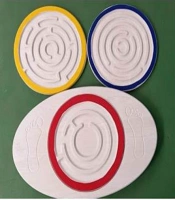
.jpg)
